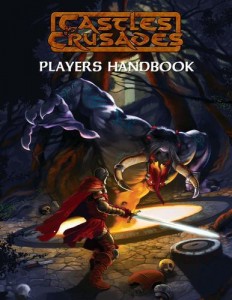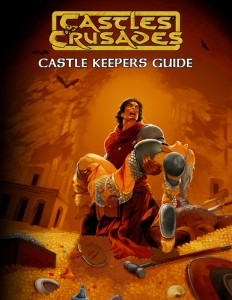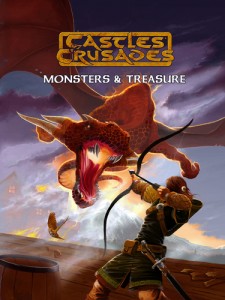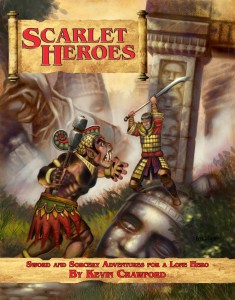House Rules
 If you’re not a tabletop gamer or have no interest in tabletop gaming you should read no further unless you want to be bored or roll your eyes.
If you’re not a tabletop gamer or have no interest in tabletop gaming you should read no further unless you want to be bored or roll your eyes.
Long-time visitors are probably aware that I’ve been gaming off and on since junior high in the ’70s, when I was introduced to Dungeons & Dragons by my old friend Sean Connelly. Sometimes a couple of years will pass, but I always seem to come back to gaming, attracted by the allure of group storytelling and the camaraderie of sitting around with friends and family.
While I’ve been curious about the new edition of Dungeons & Dragons and even read through the new system books, I already had Castles & Crusades, and I remain attached to it, possibly because I’m sort of tired of learning new systems but also because it works quite well. Here’s an articulate essay on just what C&C is and how it works, if you’re curious. (I also like that you really don’t need anything more to run C&C than the Player’s Handbook and the Monsters & Treasure book. The C&C version of the DM’s guide, the Castlekeeper’s Guide, has alternate rules and add-ons, but isn’t at all necessary for running the game.)
I love how rules simple C&C is. There really aren’t very many rules, and they’re pretty consistent.
 I occasionally find people who object that there are no feats or skills, but in my experience feats and skills lead to rules bloat that slows down the story. One of the reasons people play archetypes is that feats and skills are implied — and it must be said that there are many optional systems, some included in free C&C compatible products and some included in the companion volume to the series (the Castle Keeper’s Guide) that allow Advantages, which are similar to feats.
I occasionally find people who object that there are no feats or skills, but in my experience feats and skills lead to rules bloat that slows down the story. One of the reasons people play archetypes is that feats and skills are implied — and it must be said that there are many optional systems, some included in free C&C compatible products and some included in the companion volume to the series (the Castle Keeper’s Guide) that allow Advantages, which are similar to feats.
I understand C&C isn’t everyone’s cup of role-playing tea, and it’s not the ONLY system I use. You probably know that I’m a big fan of Savage Worlds, and I’ve gushed about Dungeon Crawl Classics, Barbarians of Lemuria and Whitehack without describing them in detail yet (I know, I know, I’ll get to it). But I introduced my players to C&C a few years ago and they like it pretty well, and I find that even after an absence I still recall the rules. There’s a lot to be said for that.
The only mechanics criticism of Castles and Crusades I’ve read that seemed to hold any validity was that saving throws didn’t scale as well as they should, but I found a house rule online that fixed that.
 I love how easy the system is to adjust or add or subtract things to, so, for instance, I port over some abilities from other games’ versions of character classes to better fit my idea of the Barbarian class, to tweak the Rogue class, and what have you. But I also have developed a number of house rules over the years that I use in any D&D style game. And that’s the real point of this post — I’m sharing my house rules and am curious to hear about yours.
I love how easy the system is to adjust or add or subtract things to, so, for instance, I port over some abilities from other games’ versions of character classes to better fit my idea of the Barbarian class, to tweak the Rogue class, and what have you. But I also have developed a number of house rules over the years that I use in any D&D style game. And that’s the real point of this post — I’m sharing my house rules and am curious to hear about yours.
Hero Points
I don’t recall from what game we originally picked this rule up, but I’ve been awarding hero points/bennies to players for years. They allow a re-roll or a one-time bonus of +10 to a roll. Generally I award 3 hero points per game, but exceptional role-playing merits an additional in-game award of a hero point. Until I started playing Savage Worlds it wasn’t a physical effect, but I’ve grown fond of handing over little rounded stones so people have tokens to use.
Criticals/Fumbles
There are a lot of options for handling critical hits and fumbles. A critical hit is generated on a pure 20, a fumble on a 1, and in some systems a critical has to be confirmed by rolling again to see if it’s a regular hit.
I prefer heroic games, so a critical is a critical without the additional confirmation. A fumble, though, has to be confirmed not just by rolling another miss, but by rolling another fumble. That keeps the comedy and frustration lower and better simulates a good sword-and-sorcery story. How often does even young Conan ever drop his sword? I don’t recall that he does.
Dice
Using a single d20 can be kind of swingy, as any tabletop player can tell you. I got this tip from Howard Tayler at GenCon three years ago. Rather than using a D20 he suggests 2 d10, added together. I love this. Numbers resulting from a roll in the middle of the range are statistically far more common, and things at the low or high end are less likely. That makes criticals a little more rare, and makes the aforementioned fumbles even harder to generate. (You have to roll double 1s twice in a row.)
Perception
I was always a little flummoxed that there was no good Perception score. Some people use the Wisdom stat to roll for surprise and intuition, but, going back again to Conan, he seemed pretty perceptive even before he was wise.
So I just use a 7th statistic, Perception, for instances of surprise and intuition. (I tried having characters add the stat bonus to their initiative rolls, or combine that bonus with Dex and divide in half, but I think I’m just going to drop back to using Dex for initiative.)
Other Stats
Sometimes we’ve used an appearance stat, but my players and I prefer to just choose that ourselves. And I’ve seen some good write-ups on a luck stat, but we’re pretty pleased with our hero point system. Besides, seven stats seems like enough.
Experience
I’ve gotten really loose about awarding experience points. Anymore, I just tell the players when it’s time to level up and they seem fine with that. For us it’s more about the story than the number tracking.
From Pathfinder, though, I do like the idea that attribute stats can rise every few levels. It makes sense that characters can get stronger, and certainly they can get wiser! Currently I’m allowing players to choose an attribute to raise every three levels, but I might move it up to every four, depending on how this works. We have rarely played a game where the campaign lasted longer than 10th or 12th level, so every three levels is probably right. In my rpg world view, 10th or 12th level ought to be about the best you can get.
Magic
I’m not a huge fan of Vancian fire and forget magic, because that’s usually not the way it works in the fiction I love. Instead I’m using the optional Mana rules from the Castles & Crusades Castlekeeper’s Guide. The basic concept is that at each level, a spell user has so many Mana points per day. Casting a 0 level spell costs one point, casting a 4th level spell costs 5. You get the idea.
I play that the characters are allowed to throw spells at their level or lower with no problem. They’re also allowed to try to throw spells they know that are over their level, rolling against the statistic that they use to power their magics (usually Intelligence). But for ever level over their own they get a -1 from the roll. So far this is working nicely, and it means there’s an occasional backlash, which I’ve partly modeled off of old Talislanta and partly off of Dungeon Crawl Classics.
Of course learning these spells is a trick. They don’t just get them out of the air — they have to be found, taught, or meditated over, etc. depending upon what kind of spellcaster the player has created.
 Traits
Traits
I love all kinds of mechanical ideas and settings created by Kevin Crawford (he’s a brilliant game designer and writer, which is why I have hard copies of most of his game systems). Because he writes for Labyrinth Lord/Swords &Wizardry/ old school roleplaying games, all of his ideas work well with Castles & Crusades.
One idea I’m quite taken with is the concept of traits, which he introduced in his Scarlet Heroes book. He writes that with a trait you use “a few words to describe something the character has been or is good at doing.” Maybe your fighter is an excellent hunter, or maybe your non bard actually is a great singer. Those are all character bits, of course, but a trait allows you to drop a few points into that characteristic (the more specific, the better) to be able to roll to succeed on something that makes your character unique. Only a few trait points are awarded at creation and with each level.
They’re not meant to be feats, or skills, although from my examples you see that they also can be used to add a little non-class customization to a character. They also can be indicative of background, like, “three years apprenticed on a ship” or of a little bit of character oomph: “iron constitution.” There’s no codified list, just an agreement between player and GM about what the trait will mean and a discussion when the player wants to use it.
I haven’t tried using traits yet, but I’m attracted to the idea. Freeform and fun is good, rules bloat is bad.
Alright — that’s what I have. I’ll be very curious to hear if anyone else has some favorite house rules!
12 Comments